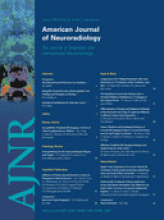Abstract
BACKGROUND AND PURPOSE: The T2-weighted gradient-echo (GRE) imaging is currently the gold standard MR imaging sequence for the evaluation of patients with cerebral cavernous malformation (CCM) lesions. We aimed to compare the sensitivity of susceptibility-weighted imaging (SWI) with T2-weighted fast spin-echo (FSE) and GRE imaging in assigning the number of CCM lesions in patients with the familial form of the disease.
Materials and METHODS: We studied 15 patients (8 men, 7 women; mean age, 34 years) with familial CCM. All patients underwent MR imaging with the following sequences: T1-weighted spin echo, T2-weighted FSE, T2-weighted GRE, and SWI. Two neuroradiologists read the images regarding the number of lesions seen on each sequence. The final decisions were reached by consensus. The number of lesions on the different sequences was compared with analysis of variance, followed by a nonparametric Wilcoxon matched-pairs signed rank test.
RESULTS: The number of lesions was higher on T2-weighted GRE than on T2-weighted FSE (P = .001). In addition, more lesions were seen on SWI than on T2-weighted GRE (P = .001) and FSE (P = .001) sequences.
CONCLUSION: The sensitivity of SWI in assigning the number of CCM lesions in patients with the familial form of the disease is significantly higher than that of T2-weighted FSE and GRE sequences.
- Copyright © American Society of Neuroradiology












